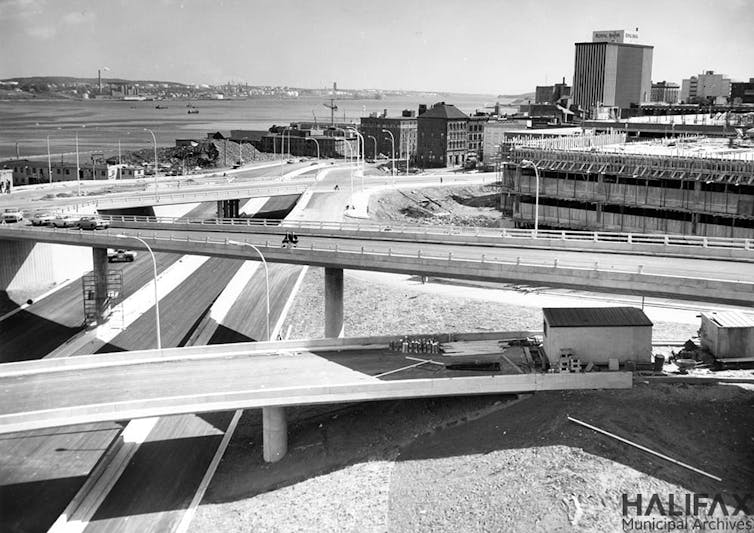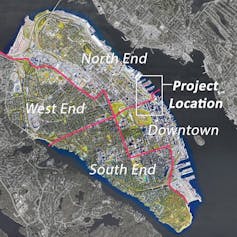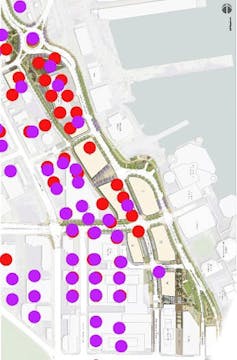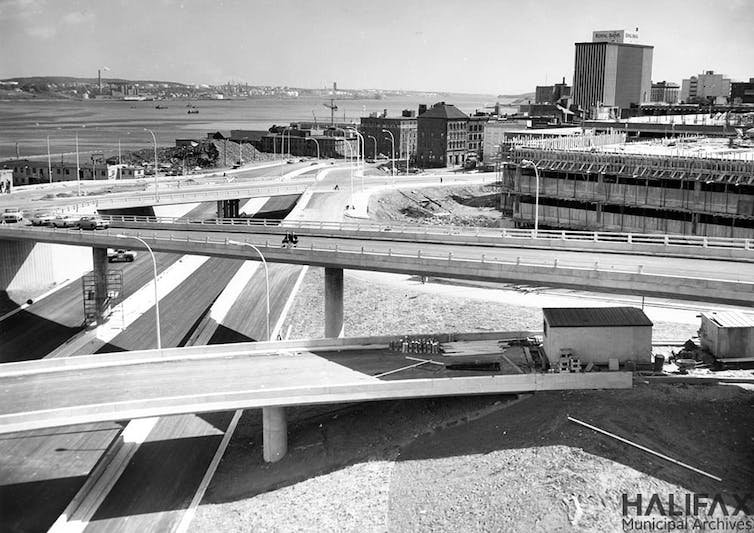The African Nova Scotian community has long struggled with displacement and erasure when it comes to urban planning. In Halifax, racism has influenced planning and civic governance decisions. The demolition of Africville in the 1960s and subsequent expropriation without compensation are well-documented examples of injustices.
The Halifax Regional Municipality issued a formal apology in 2015, yet racism persists. In the years since, there has been little substantial action to emplace African Nova Scotian residents in Downtown Halifax.
The Cogswell District Project is a new opportunity to heal historic divides. The project is a mixed-use residential district planned on the site of the former Cogswell highway interchange in downtown Halifax.
The elevated interchange was at the epicentre of a 1960s-era urban renewal project to construct a highway system through downtown Halifax. Construction of the infrastructure, including modernist commercial centres and high rises, led to the demolition of entire residential streets and displacement of thousands of vulnerable residents, including many of the city’s poorest citizens.
As urban planner Jill Grant wrote, “Most Haligonians seemed to view the project as obliterating an obnoxious and embarrassing slum. Neither politicians nor planners took account of the people who lived in the area.”
Even as the Cogswell Interchange was being constructed, some Halifax residents began to protest against the destruction of the city’s fabric. In 1970, the highway project was halted, before it destroyed what remained of Halifax’s now beloved harbourfront. It took another half century for civic leaders to unwind this mid-century highway investment and order the deconstruction of the interchange now known as the “Road to Nowhere.”

(Halifax Municipal Archives), Author provided (no reuse)
New urban designs for public space, road layouts and development blocks aim to knit physical separations between north and south in this Downtown Halifax area. These are promising, but the project must also seize the opportunity to heal other, more serious divisions with housing, class inequities and racial schisms.
The vision put forth by urban designers depicts a diverse community, but fostering that diversity in the future Cogswell District requires more than a false nod to inclusion.
Gentrification and erasure
Currently, construction of expensive housing developments on sites that were once affordable apartments in the North End is pushing residents out of the city in search of affordable housing, far from their roots and their established communities. This more recent wave of gentrification has been referred to as “Africville 2.0.”

Author provided (no reuse)
Thus far, city officials have sidestepped important questions about future land divestment, affordable housing and zoning. Without action, this profound chance for housing and community building will be missed.
Halifax Regional Municipality has promised to include some form of affordable housing in the future Cogswell District, but it is unclear what is meant by affordable.
A density bonusing program has been established to encourage the creation of public benefits including affordable housing by the private sector. But when given the choice, developers often choose to pay fees or provide amenities such as public art rather than build low-income housing.
The municipal government is currently discussing new Inclusionary Zoning policies. However, even if implemented, they will not address particular emplacement goals such as housing for racialized people.
“Blight Removal” in Halifax’s past
Exploring the connection between historic displacement in the Cogswell neighborhood and the prospects of emplacement for low-income residents today was a focus for a recent Jane’s Walk, hosted by myself and local resident Treno Morton, in celebration of renowned urbanist Jane Jacobs.
Urban renewal goals in 1960s Halifax were twofold: the creation of a brand new harbourfront highway system and the removal of problematic housing. Cogswell presents a prime example of similar renewal programs criticized by Jacobs in her influential 1961 book, The Death and Life of Great American Cities.

(Halifax Municipal Archives), Author provided (no reuse)
Our walk toured the original targets of “blight removal” initiated by architect Gordon Stephenson, who was hired in 1957 to create a strategy for slum clearance in Halifax.
Having trained under Swiss-French architect and revolutionary city planner Le Corbusier in the early 1930s, Stephenson brought a modernist’s zeal to his work. He produced maps with oversized dots representing perceived social ills such as households on welfare or children appearing in juvenile court.
This skewed mapping exercise led to a sweeping program of erasure. Backed with federal, provincial and civic funds, homes were removed throughout the 1960s. Some people were relocated to new housing projects in the city’s North End. However, rehousing efforts were inadequate and thousands of residents were forced to move away from the district.
Bridging Divides

(Author provided), Author provided (no reuse)
Halifax Regional Municipality’s council opted to redevelop the district in 2013. In the decade since, the municipality has conducted extensive public consultation as a “cornerstone” of the planning process.
Thus far, the planning and design efforts have focused on street shapes and public space design, right down to fountains, bike lanes and benches.
However, meaningful dialogue about housing affordability and inclusion has been sidestepped and land divestment remains a sensitive issue that planners and council members say they will address at some point in the future. Funds from the sale of development blocks will be used to pay for the cost of the project, but maximizing sale revenues will not create affordable housing.
If the historic displacement of the African Nova Scotian community in Halifax is to be addressed in a genuine way, more substantial measures must be taken with land divestment in Cogswell District.
A targeted housing strategy is needed and must be supported by all orders of government responsible for the interchange debacle in the first place. Without a sincere commitment to these actions, lower-income African Nova Scotian families will continue to struggle with displacement in their city.

Felecia Phillips Ollie DD (h.c.) is the inspiring leader and founder of The Equality Network LLC (TEN). With a background in coaching, travel, and a career in news, Felecia brings a unique perspective to promoting diversity and inclusion. Holding a Bachelor’s Degree in English/Communications, she is passionate about creating a more inclusive future. From graduating from Mississippi Valley State University to leading initiatives like the Washington State Department of Ecology’s Equal Employment Opportunity Program, Felecia is dedicated to making a positive impact. Join her journey on our blog as she shares insights and leads the charge for equity through The Equality Network.




